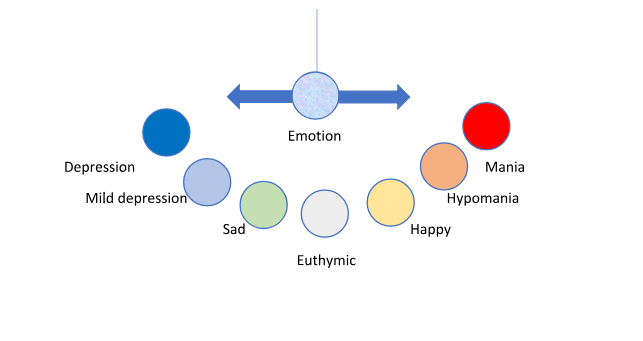Bipolar Disorder is a mood disorder in which individuals experience extreme moods ranging from depression to mania. It is helpful to conceptualize Bipolar Disorder, and mood in general, as a pendulum that swings back and forth on an emotional continuum that ranges from depression to mania (see graphic below).

individuals who do not have a mood disorder the pendulum gradually swings from happy to sad and is usually in response to external events, such as feeling really good after getting a promotion at work or feeling really low after an unwanted break-up. These emotional states are usually temporary and a person’s mood eventually returns to a more neutral state. In Bipolar Disorder the pendulum can swing to extreme emotional states where sadness becomes depression and happiness becomes mania. The rate at which the pendulum swings can be rapid and can get stuck at either emotional extreme where it seldom returns to a euthymic state (a resting state in which there is no emotional extreme). External events can contribute to these severe emotional swings or they can be experienced for no obvious reason.
There is an additional emotional disorder (see above graphic) called Cyclothymia that falls in between the “normal mood” range and Bipolar Disorder. Individuals who have Cyclothymia have moods that range from mild depression to hypomania and, similar to Bipolar Disorder, the changes in mood can be rapid and can get stuck at either emotional extreme.
Listed below are some of the symptoms of depression, mild depression, Mania, and Hypomania.
Depression
- Depressed mood most of the day for most days
- Increased need for sleep or insomnia
- Fatigue and loss of motivation
- Difficulty with focus and decision-making
- Feelings of worthlessness or guilt
- Significant and unintentional weight loss or weight gain
- Hopelessness
- Recurrent thoughts of death or suicidal ideation
Mild depression
- Change in appetite
- Insomnia or hypersomnia
- Fatigue
- Low-self-esteem
- Difficulty focusing
- Lack of “joy”managing bioloar Disorder
- Apathy
Mania
- Irritability or anger
- Euphoria
- Decreased need for sleep
- Racing and tangential thoughts
- Hyperverbal speech (talking too much/too fast)
- Impulsivity/risky behavior
- High anxiety
- Anger
- Psychosis
Hypomania
- Rapid speech
- “Really good” mood
- Difficulty sleeping
- Difficulty with focus
- Inflated thoughts of self-worth
- Anxiety
As explained by the above graphic and list of symptoms, individuals with Bipolar Disorder are continuously trying to manage emotional extremes, which can be an exhausting and lifelong battle. It is not as easy as simply willing oneself to “cheer-up” or “calm-down.” Bipolar Disorder frequently has a negative effect on employment, school, developing and maintaining relationships, and overall self-care. Learning to manage the symptoms of Bipolar Disorder is essential to improving one’s confidence, relationships and overall quality of life.
Learn more about managing Bipolar Disorder by meeting with a licensed therapist who specializes in treating affective disorders.



